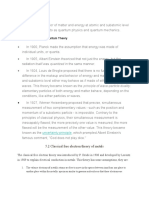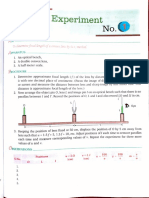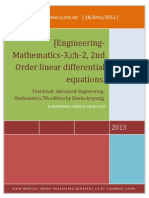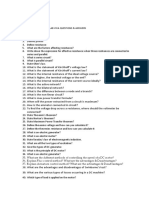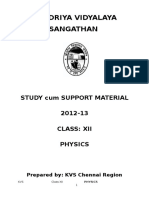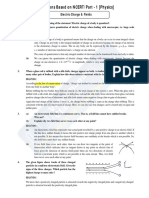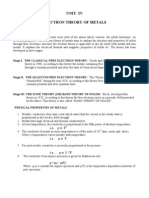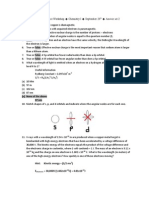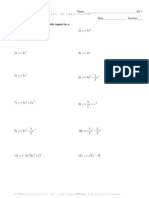Free Electron Theory 2015-16 (VTU) PDF
Free Electron Theory 2015-16 (VTU) PDF
Uploaded by
U and me SCopyright:
Available Formats
Free Electron Theory 2015-16 (VTU) PDF
Free Electron Theory 2015-16 (VTU) PDF
Uploaded by
U and me SOriginal Title
Copyright
Available Formats
Share this document
Did you find this document useful?
Is this content inappropriate?
Copyright:
Available Formats
Free Electron Theory 2015-16 (VTU) PDF
Free Electron Theory 2015-16 (VTU) PDF
Uploaded by
U and me SCopyright:
Available Formats
FREE ELECTRON THEORY
Electron Theory of Metals
The electrons in the outermost orbitals of the atoms, which constitute the solid,
determine its electrical properties. The electron theory of solids aims to explain the
structures and properties of solids through their electronic structure. The electron theory
is applicable to all solids both metals and non-metals. It explains the electrical, thermal
and magnetic properties of solids etc. The theory has been developed in three main
stages.
(i) The Classical Free Electron Theory:
Drude and Lorentz developed this theory in 1900. According to this theory, the metals
containing free electrons obey the laws of classical mechanics.
(ii) The Quantum free electron theory:
Sommerfeld developed this theory during 1928. According to this theory, free electrons
obey quantum laws.
(iii) The Zone theory:
Bloch stated this theory in 1928. According to this theory, the free electrons move in a
periodic field provided by the lattice. This theory is also called "Band theory of solids".
Concept free electron:
Atoms in metallic solids are bound together by metallic bonds in which the
valence electrons are free to move. Effectively, the valence electrons become conduction
electrons. The electrons do not belong to a particular atom but belong to the complete
bulk material as a whole. Thus each such electron is named a free electron. Usually, one
or two electrons per atom are free to move. The free electrons move randomly in absence
of electric field. This motion is similar to the motion of molecules in a gas. Such a large
aggregate of free electrons moving in the properties of metals like electrical conduction
in a solid, they are also called conduction electrons..
The atoms without one of its valence electrons becomes a positive ion. These ions
are not free to move. A regular periodic array of points in three dimensions is known as a
lattice. The ions are fixed to the lattice points. Thermal vibrations of ions at lattice points
causes elastic waves in crystals.
The Classical Free Electron Theory of Metals (Drude-Lorentz theory of metals)
The classical free electron theory is based on the following postulates:
(a) In an atom electrons revolve around the nucleus and a metal is composed of such
atoms.
(b) The valence electrons of atoms are free to move about the whole volume of the
metals like the molecules of a perfect gas in a container. The collection of valence
electrons from all the atoms in a given piece of metal forms electron gas. It is free to
move throughout the volume of the metal.
(c) These free electrons move in random directions and collide with either positive ions
fixed to the lattice or other free electrons. All the collisions are elastic i.e. there is no loss
of energy.
(d) The movements of free electrons obey the laws of the classical kinetic theory of
gases.
(e) The electron velocities in a metal obey the classical Maxwell - Boltzmann distribution
of velocities.
Prepared by SHANKER RAO.G, (9949435575) Page 1
(f) The free electrons move in a completely uniform potential field due to ions in the
lattice.
(g) When an electric field is applied to the metal, the free electrons are accelerated in the
direction opposite to the direction of applied electric field.
Thermal velocity:
The ionic cores, though they fixed in the lattice frame, will be vibrating constantly
about their respective mean positions. The vibration is because of thermal agitation. The
thermal agitation also causes the conduction
electrons to keep moving constantly inside the
metal. The velocity with which the free electrons
keep moving due to thermal agitation is called
thermal velocity. Due to such a motion, they
undergo incessant collisions with the lattice points,
i.e., the ionic cores.
When an electron collides with the lattice, the direction to which it had confined
its motion prior to the collision is abandoned, and it starts moving in a different direction.
Since collision is a random process, the two directions do not have any interrelation. This
is the kind of randomness in the motion of a free electron. Thus in the absence of an
electric field, though the free electrons in motion, it does not give rise to a current due to
the randomness in their motion.
As per laws of kinetic theory of gases, the energy associated with each electron at
3
a temperature T will be kT , where k is the Boltzmann constant. It is related to the
2
kinetic energy through the relation,
3 1
kT mvth2
2 2
3kT
vth
m
Drift velocity:
When an electric field is applied, there will be a net displacement in the randomly
moving free electron positions with time in a direction opposite to the direction of the
field. This displacement in unit time is called drift velocity which will be constant for the
free electrons in the steady state and accounts for a current in the direction of field.
If m is the mass of the electron, vd is the drift velocity and is the mean collision
time, then the resistance force Fr offered to its motion is given by
mv d
Fr
If e is the charge on the electron and E is the strength of the applied field then the driving
force acting on the electron is,
F = eE
mv d
In the steady state, Fr = F, i.e., eE
eE
The drift velocity v d is given by v d
m
Prepared by SHANKER RAO.G, (9949435575) Page 2
Mobility of electrons ( ):
The magnitude of the drift velocity acquired by the electrons in unit electric field
is called the mobility of the electrons.
If E is the electric field and v d is the drift velocity of the electrons, then the
vd
mobility of electrons is given by -------------(1)
E
It is measured in m 2 / Vs , for small electric fields the value of is independent of the
value of E.
J E -------------(2)
J I nev d A nev d
E AE AE E
ne -------------------------(3)
ne
ne 2 1 ne 2
Now
me ne me
e
-------------------------(4)
me
Inserting the appropriate values of in Eq (4) yields mobilities of 0.18 10 1 m 2 / Vs for
semiconductors and 1.8 10 3 m 2 / Vs for metals. It is different for different materials.
Mean free path λ:
According to kinetic theory of gases, the average distance travelled by a gas
molecule in between two successive collisions with other molecules is mean free path. In
the classical theory of free electron model, it is taken as the average distance travelled by
the conduction electrons between successive collisions with the lattice ions.
Mean collision time τ:
The average time that elapses between two consecutive collisions of an electron
with the lattice points is called the mean collision time.
If v is the total velocity of the electrons which is the velocity due to the combined
effect of thermal and drift velocities, then the mean collision time is given by
v
Where, is the mean free path
If v d is the drift velocity, then v d vth
Relaxation time τr:
In a metal, due to randomness in the direction of motion of the conduction
electrons, the probability of finding an electron moving in any given direction is equal to
finding some other electron moving in exactly the opposite direction in the absence of an
electric field. As a result, the average velocity of the electrons in any given direction
becomes zero.
i.e., vav= 0, in the absence of the field.
Prepared by SHANKER RAO.G, (9949435575) Page 3
However, when the metal is subjected to an external electric field, there will be a
net positive value v’av for the average velocity of the conduction electrons in a direction
opposite to the direction of the applied field which is equal to the drift velocity.
i.e., vav= v’av, in the presence of the field.
If the field is turned off, the average velocity vav starts
reducing exponentially from the value v’av .
The decay process follows the equation,
v av v av
'
e t / r ---- (1)
Where, t is the time counted from the instant the field
is turned off and r is a constant called the relaxation
time which is specific to the particular metal.
If t r , then
v av v av
'
e 1
1 '
v av
e
Thus relaxation time is defined as, the time required for the average velocity of free
electrons to reduce to 1/e times its value that existed when the field is just turned off.
Success of classical free electron theory
1) It verifies Ohm's law.
2) It explains the electrical and thermal conductivities of metals.
3) It derives Wiedemann-Franz law. (i.e. the relation between electrical conductivity and
thermal conductivity)
4) It explains optical properties of metals.
Failure of classical free electron theory
In spite of the success seen above, classical theory has the following drawbacks.
1. The phenomena such as photoelectric effect, Compton Effect and the black body
radiation couldn't be explained by classical free electron theory.
2. According to the classical free electron theory the value of specific heat of metals is
given by 4.5 R, where R-is the Universal gas constant whereas the experimental value
is nearly equal to 3 R. Also according to this theory the value of electronic specific heat is
3
equal to R . while the actual value is about 0.01 R only.
2
3. Electrical conductivity of semiconductor or insulators couldn't be explained using this
model.
K
4. Though is a constant (Wiedemann Franz Law) according to the Classical free
T
electron theory, it is not a constant at low temperature.
5. Ferro magnetism couldn't be explained by this theory. The theoretical value of
paramagnetic susceptibility is greater than the experimental value.
Quantum free electron theory
The quantum free electron theory is developed by Sommerfeld retained some of
the assumptions of the classical free electron theory and introduced a few new
assumptions. The quantum free electron theory was successful in eliminating certain
drawbacks of the classical theory.
Prepared by SHANKER RAO.G, (9949435575) Page 4
Assumptions:
1. The energy values of the conduction electrons are quantized. The allowed energy
values are realized in terms of a set of energy levels.
2. The distribution of electrons in the various allowed energy levels occurs as per
Pauli Exclusion Principle.
3. The free electrons travel in a constant potential inside the metal but stay confined
within its boundaries.
4. The attraction between the free electrons and the lattice ions, and the repulsion
between the electrons themselves are ignored.
Density of states:
The Fermi function gives us only the probability of occupation of a quantum
energy state by a single electron. The ability of a metal to conduct electricity depends on
how many quantum energy states are available to for electrons and what are the energies
of those states. In physics, a quantum state is characterized by a set of quantum numbers
and represented by an Eigen function. It is not an easy
task to list the energies of so many states individually,
instead of this, we find the number of states in a unit
volume of the sample having energies in the range E and
E+dE. We write this number as N(E)dE, where N(E) is
called the density of states at energy E. this unit of N(E)
is states per cubic meter per electron volt (m-3eV-1).
We know that the permitted energy levels for
electrons in a solid material will be in terms of bands. Let
the energy band be spread in an energy interval between
E1 and E2 in the material. Consider an infinitesimal small increment dE at arbitrary
energy value E in the band. Since dE is an infinitesimally
small increment in E, we can assume that N(E) remains
constant between E and E+dE. Then the number of energy
levels in the range E and E+dE is obtained by evaluating the
product of N(E) and dE.
4
N ( E ) dE 3 2 m E 1 / 2 dE
3/2
h
As per the above equation it is clear that, the number of energy
states in an energy interval dE is proportional to E . A plot
of N(E) verses E gives the curve of parabola
Fermi energy and its importance:
Fermi level is the maximum energy level up to which the
electrons can be filled at 0 K. it is the energy of a state
which the probability of electron occupation is half at any
temperature above 0 K.
The important features of Fermi energy level are:
1. Fermi level acts as a reference level that separates
the vacant and filled states at 0 K.
2. At absolute zero, all the quantum states below EF
are occupied while all the quantum states having
energies greater than EF are unoccupied.
Prepared by SHANKER RAO.G, (9949435575) Page 5
3. When the temperature is increased, few electrons gain the thermal energy and
jump to the higher energy levels.
4. Fermi energy denotes the maximum kinetic energy that electrons can posses at 0
K.
5. Fermi energy levels are used to explain the flow of electrons when two metals are
brought into contact.
Fermi-Dirac distribution:
In a metal, in the absence of an electric field, free electrons move at random,
similar to the behavior of the electron gas. Since electrons are indistinguishable particles,
they are known as fermions or Fermi particles. Hence, such an electron gas obeys Fermi–
Dirac statistics. The Fermi – Dirac statistics describes the behavior of free electron gas,
taking into account of quantum theory and Pouli’s exclusion principle. The highest
energy level occupied by electrons at absolute zero temperature is known as Fermi
energy level which divides the occupied states from the unoccupied states. The
probability of energy level E F by an electron at temperature T is given by
1
F (E) E E F / K BT
Where F(E) is
1 e
the Fermi factor, E F energy of Fermi level and K B is the
Boltzmann’s constant. The probability function F(E) lies
between 0 and 1 depending on the energy E and the
temperature T and below the Fermi energy EF all the
energy levels occupied by electrons. Each level occupied by two electrons, one with the
spin up and the other with the spin down. All the energy levels above EF are vacant.
Fermi factor:
At temperatures above absolute zero, though the material will be receiving
thermal energy from the surroundings, the amount of thermal energy supplied will be
quite small. At ordinary temperatures, the electrons which are in energy levels far below
the Fermi level cannot absorb this energy. It is because, there is no availability of vacant
higher energy levels into which the electrons can come into if their energies increase only
by a small amount. However, near the Fermi level there are unoccupied higher energy
levels which lie above the occupied energy levels. Those are the energy levels into which,
the electrons from the energy levels near Fermi level could get into after absorbing
thermal energy.
Though such thermal excitations seem to be random, the resulting distribution of
electrons in various energy levels after excitation will be not random but a systematic
one. The distribution is always governed by a statistical function once the system is in
thermal equilibrium.
The probability N(E) that a given energy state with energy E is occupied at a steady state
temperature T is given by
1
F (E) E E F / K BT
1 e
Where F(E) is the Fermi factor and K B is the Boltzmann’s constant.
Prepared by SHANKER RAO.G, (9949435575) Page 6
Effect of temperature on Fermi-Dirac Distribution:
Let us plot the distribution function against energy at different temperatures. From
the plots
Case I: at temperature T =0 k
E EF
(a) For E < EF , and F(E) =1
K BT
E EF 1
(b) For E > EF , and F(E) = =0
K BT
Thus, at absolute zero temperature F(E) is a step
function. All the states with energies up to F(E) are
empty. Thus the fermi level may be defined as the
topmost filled level at absolute temperature.
Case II: at temperature T >0 k
E EF
(a) For E<EF , is negative and F(E) 1 for E<<EF
K BT
E EF
(b) For E > EF , is positive and F(E) 0 for E>>EF
K BT
E EF
(c) For E = EF , = 0 and F(E) = ½
K BT
Thus, at finite temperature the probability of occupancy of the Fermi level is ½. The
fermi function when multiplied with the density of states gives the number of states
per unit volume actually occupied by electrons.
Fermi velocity vF:
The energy of the electrons which are at the Fermi level is EF. The velocity of the
electrons which occupy the Fermi level is called the Fermi velocity vF.
1
E F mv F2
2
1
2E F 2
vF
m
Effective mass m * :
When a metal is subjected to the influence of an electric field, a free electron in
the metal moves under the combined influence of the applied electric field and that of
a periodic potential due to lattice ions. Because of such a superposed effect, the
electron responds as if it possesses a mass called effective mass which is different
from its true mass with which it is accounted if it were to be under the influence of
external field alone.
Expression for electrical conductivity based on quantum free electron theory:
Sommerfield realized that, the free electrons obey Fermi-Dirac statistics as
compared to the gas molecules which are known to obey Maxwell-Boltzmann
statistics. Hence by applying Fermi-Dirac statistics and by using Boltzmann transport
equation, he arrived at an expression for electrical conductivity of metals is given by
ne 2
*
m vF
Prepared by SHANKER RAO.G, (9949435575) Page 7
When an external electric field E is applied to the metal, the force exerted on a free
electron is given by
F eE ------------------ (1)
Since force is also the rate change of momentum, we can write
dp
F ------------------ (2)
dt
dp
eE ------------------ (3)
dt
From de Broglie hypothesis
h h 2
p k ------------------ (4)
2
By substituting Eq (4) in Eq (3) we get
dk
eE
dt
eE
dk dt ------------------ (5)
The above equation shows that, the origin of k space moves through a distance dk in
time dt on application of external electric field, E. due to collisions of free electrons
with the imperfections, the displacement of k space becomes steady (= k ) and then
c is the average collision time.
eE
k c ------------------ (6)
Since p mv k , the change in velocity v is given by
v k ------------------ (7)
m
From Eq (6) and (7)
eE eE c
v c ----------------- (8)
m m
If the number of electrons per unit volume (electron density) is n, then the current
density J is given by
J n(e)v ------------------ (9)
From Eq (8) and (9) we get
eE c ne 2 E c
J n ( e)
m m
J E (Ohm’s law)
Where the electrical conductivity is given by
ne 2 c
m
Merits of quantum free electron theory:
The quantum free electron theory has been successful in according for many
experimental facts which the classical free electron theory failed to account for.
1. It is successfully explains the electrical and thermal conductivity of metals.
2. Phenomenon of thermionic emission can be explained by this theory.
Prepared by SHANKER RAO.G, (9949435575) Page 8
3. Temperature dependence of conductivity of metals can be explained by this
theory.
4. It explains the specific heat of metals.
5. It explains the magnetic susceptibility of metals.
Demerits of quantum free electron theory:
1. It is unable to explain the metallic properties exhibited by only certain crystals.
2. It is unable to explain why the atomic arrays in metallic crystals should prefer
certain structure only.
Semiconductors:
A substance which has resistivity in between conductors and insulators is known
as semiconductor.
Semiconductors are broadly classified in to two categories.
(1) Intrinsic semiconductors
(2) Extrinsic semiconductors
Intrinsic semiconductors:
If a semiconductor is sufficiently pure, then it
is known as intrinsic semiconductor. Ex: pure Ge,
pure Si etc
At low temperatures all, the valence
electrons are bound to the atoms through covalent
bonds. But at higher temperatures when thermal
energy (kT) becomes comparable with the bond
energy, some of the covalent bonds will be broken
and electron hole pairs will be generated. The
electrons can occupy conduction band and holes
will be created in the valance band. Each broken covalent bond generates one electron
and a hole pair. Thus the electron and hole density in an intrinsic semiconductor will be
equal and will be depending on the number of broken covalent bonds.
Electron density (concentration) in Intrinsic Semiconductors:
Let dn be the number of electrons per unit volume available between energy
interval E and E+dE in the conduction band.
dn =Zc(E)Fn(E)dE------------------ (1)
where Zc(E)dE is the density of states in the energy interval E and E+dE and F(E) is the
Fermi-Dirac distribution function which represents the probability that a state of energy E
occupied by an electron.
If Ec is the energy at the bottom of the conduction band, the density of electrons in the
conduction band can be calculated by integrating eq.(1) i.e.
ne Z E F E dE -------------------(2)
EC
C n
since the probability of electrons occupying the upper level of conduction band reduces
to zero at infinity, the upper limit of integration is therefore taken as infinity.
We know that the density of states within the enrgy interval E and E+dE is given by
Prepared by SHANKER RAO.G, (9949435575) Page 9
4
3
Z C E dE 3
(2me* ) 2 E 1 / 2 dE ---------------------- (3)
h
*
Where me is the effective mass of the electron.
Since the energy E starts at the bottom of the conduction band Ec, we can write
4
3
Z C E dE 3 (2me* ) 2 E Ec dE ---------------------- (4)
1/ 2
h
Probability os an electron occupying an energy state E is given by
Fn E
1
EE
------------------------ (5)
F
1 e kT
Where E F is the energy of the Fermi level which lies exactly at the centre of the
forbidden energy gap in intrinsic semi conductor. i.e.
E EV
EF C ---------------------- (6)
2
Where EV is the energy corresponding to the top of the valance band.
Substituting the values of Zc(E)dE and F(E) from Eq(4) and Eq(5)
* 2 E E C
4
3 1/ 2
n e 3 ( 2m e ) E E F dE ---------------------- (7)
EC h
1 e kT
For all possible temperatures E EC >>kT
Then the term 1 in the denominator of the integrand can be neglected so that
4
3
E EC 1 / 2
ne 3 ( 2me* ) 2 E EF dE
EC h
e kT
EF E
4
3
= ( 2 m * 2 kT
e ) e E E E C 1/ 2
e kT
dE
h3 C
Let E EC x E EC x
dE = dx when E EC , x 0
By substituting the above we have
EF EC x
4
3
ne 3 (2me* ) 2 e kT x e kT
1/ 2
dx
h 0
E F EC x
4 3
3 (2me* ) 2 e kT x e kT dx ---------------------- (8)
1/ 2
h 0
From gamma function
x
x e kT
dx kT
1/ 2 3/ 2
0
2
E F EC
4
3
Hence, ne 3
(2me* ) 2 e kT
kT 3 / 2
h 2
3/ 2 E F EC
2me* kT
ne 2 2 e kT
---------------------- (9)
h
Prepared by SHANKER RAO.G, (9949435575) Page 10
E F EC
ne N C e kT
---------------------- (10)
3/ 2
2me* kT
Where N c 2 2 is effective density of states of electrons at the conduction
h
band edge.
3/ 2
T
For silicon N c 2.8 10 m 3
25
300
Hole concentration in Intrinsic Semiconductors:
Let dp be the number of holes per unit volume available between energy interval
E and E+dE in the valence band
dp =Zv(E)Fp(E)dE------------------ (1)
where Zv(E)dE is the density of states in the energy interval E and E+dE and Fp(E) is the
probability of existence of a hole in an energy state E.
F p E 1 Fn E 1
1
EE F
1 e kT
E EF
kT
F p E
e
E EF
1 e kT
In the valance band E <<EF and hence
E EF
F p E e kT ------------------(2)
Density of holes in the valence band is given by
4
3
Z V E dE 3 (2mh* ) 2 E 1 / 2 dE
h
Since EV is the energy of the top of the valence band, then
4
3
Z V E dE (2mh* ) 2 EV E dE ---------------------- (3)
1/ 2
3
h
Substituting the values of Z V E dE and F p E from Eq (3) and (2) in Eq (1), we get
E E
4
3
F
dp ( 2 m * 2
h ) EV E
1/ 2
e kT
dE ---------------------- (4)
h3
The total number of holes in the valence band can be obtained by integrating Eq. (4)
E EF
4
EV 3
p 3 (2mh* ) 2 EV E e kT dE --------------------- (5)
1/ 2
h
EF E E
4 3
V
p 3 (2m h* ) 2 e kT EV E 1 / 2 e kT dE
h
Let EV E x E EV x
dE = - dx when E EV , x 0
By substituting the above we have
EF 0 EV x
4
3
p 3 (2mh* ) 2 e kT x e kT
1/ 2
dx
h
Prepared by SHANKER RAO.G, (9949435575) Page 11
EV E F x
4 3
3 (2m h* ) 2 e kT x e kT dx ---------------------- (8)
1/ 2
h 0
From gamma function
x
x e kT
dx kT
1/ 2 3/ 2
0
2
EV E F
4
3
Hence, p 3 (2mh* ) 2 e kT
kT 3 / 2
h 2
3/ 2 EV E F
2m h* kT
p 2 2 e kT
---------------------- (9)
h
EV E F
p NV e kT
---------------------- (10)
3/ 2
2mh* kT
Where N V 2 2 is effective density of holes in the valence band edge.
h
3/ 2
T
For silicon N V 2.8 10 25
m 3
300
Carrier concentration in Intrinsic Semiconductors:
If a semiconductor is sufficiently pure, then it is known as intrinsic
semiconductor. At low temperatures all, the valence electrons are bound to the atoms
through covalent bonds. But at higher temperatures when thermal energy (kT) becomes
comparable with the bond energy, some of the covalent bonds will be broken and
electron hole pairs will be generated. The electrons can occupy conduction band and
holes will be created in the valance band. Each broken covalent bond generates one
electron and a hole pair. Thus the electron and hole density in an intrinsic semiconductor
will be equal and will be depending on the number of broken covalent bonds.
Under equilibrium conditions, the number of electrons per unit volume (n) present
in the conduction band will be equal to the number of holes per unit volume (p) in the
valence band.
For intrinsic semiconductor n = p = ni------------------ (1)
Where ni is known as intrinsic carrier concentration.
Electron concentration in the conduction band is
n = Nc exp [-(E c - E F )/kT] ----------------------- (2)
hole concentration in the valence band is
p = N v exp E F E v / kT ----------------------- (3)
where Nc and Nv are known as pseudo constants depending on temperature. k is
Boltzmann constant. T is absolute temperature of an intrinsic semiconductor.
ni2 np
= Nc exp [-(E c - E F )/kT] N v exp E F E v / kT
But Ec - Ev = Eg
ni2 Nc Nv exp(Eg / kT)
Prepared by SHANKER RAO.G, (9949435575) Page 12
ni Nc Nv 2 exp(Eg / 2kT) ----------------------- (4)
1
From the above relation, it is clear that
1. The intrinsic carrier concentration is independent of the Fermi level position.
2. The intrinsic carrier concentration is a function of the band gap Eg
3. The intrinsic carrier concentration depends on the temperature T.
Fermi level in intrinsic Semiconductors:
For an intrinsic semiconductor, n = p, hence
Nc exp [-(Ec - E F )/kT] = N v exp E F Ev / kT
N c exp E F E v / kT
N v exp E c E F / kT
= exp E F Ev E c E F / kT
= expE v Ec 2 E F / kT
Ec Ev kT Nv
EF = log
2 2 Nc
When Nv = Nc, the effective density of states in conduction band and valence band is
equal, in such a case one gets from above Equation.
E Ev
EF = c
2
i.e., Fermi level lies exactly in the middle of energy gap
Intrinsic conductivity:
Consider an intrinsic semiconductor to which a
potential difference V is applied. It establishes an electric
field E and the charge carriers are forced to drift in the
respective directions to constitute an electric current I. the
drift velocity acquired by the charge carrier is
Vd E ----------------------- (1)
Where is the mobility of charge carriers.
Let n be the concentration of electrons in the semiconductor. Then the current density due
to an electron is
J n neVd
nen E
Where n is the mobility of the electron.
Similarly, current density due to holes is J p pe p E
Where p is the hole concentration and p is the mobility of the hole.
Total current density J J n J p
J ne n E pe p E
= n n p p eE ----------------------- (2)
But total current density J E ----------------------- (3)
Where is total conductivity.
Prepared by SHANKER RAO.G, (9949435575) Page 13
From Eq (2)& (3), we get
n n p p e ----------------------- (4)
For an intrinsic semi conductor, n p ni
ni e n p ----------------------- (5)
But ni N c N v 2 exp(Eg / 2kT ) ----------------------- (6)
1
N c N v 2 e(n p ) exp(Eg / 2kT ) ----------------------- (7)
1
A exp(Eg / 2kT)
Where A N c N v 2 e(n p ) is a constant ----------------------- (8)
1
Law of mass action:
The electron and hole concentrations in an intrinsic semiconductor are given by
n = Nc exp [-(E c - E F )/kT] ----------------------- (1)
and p = N v exp E F E v / kT ----------------------- (2)
As n = p = ni, we get
ni N c N v 2 exp(Eg / 2kT ) ----------------------- (3)
1
Eq (3) shows that for any arbitrary value of EF, the product of n and p is a constant. This
conclusion is known as the law of mass action. The electron and hole concentrations in an
extrinsic semiconductor are given by expressions similar to Eq(1) and Eq (2). Thus for an
n- type semiconductor,
nn = Nc exp [-(E c - E F )/kT] ----------------------- (4)
pn = N v exp E F E v / kT ----------------------- (5)
nn pn N c N v exp(Eg / kT) ----------------------- (6)
nn pn ni2 ----------------------- (7)
The above relation represents law of mass action.
For a p-type semi conductor, the above relation becomes
n p p p ni2 ----------------------- (8)
The above Eqs (7) & (8) imply that the product of majority and minority carrier
concentrations in an extrinsic semiconductor at a particular temperature is equal to the
square of intrinsic carrier concentration at that temperature.
Prepared by SHANKER RAO.G, (9949435575) Page 14
You might also like
- 6th Central Pay Commission Salary CalculatorDocument15 pages6th Central Pay Commission Salary Calculatorrakhonde100% (436)
- Quantum TheoryDocument3 pagesQuantum TheoryRitu Raj Lamsal100% (1)
- Susceptibility of MNCL2Document23 pagesSusceptibility of MNCL2AshwamedhNo ratings yet
- Quantum Theory of SolidsDocument12 pagesQuantum Theory of SolidsMeghana Chowdary ArumilliNo ratings yet
- Basic Electronics by Aggarwal IITR PDFDocument192 pagesBasic Electronics by Aggarwal IITR PDFsamNo ratings yet
- Physics PracticalDocument24 pagesPhysics PracticalAkshit Chauhan100% (1)
- Phy PracticalDocument15 pagesPhy PracticalManoj kumar JhaNo ratings yet
- Wave Optics (Xiii) Teaching NotesDocument16 pagesWave Optics (Xiii) Teaching NotesSankar KumarasamyNo ratings yet
- Georg OhmDocument4 pagesGeorg Ohmm_a_nevesNo ratings yet
- Emission and Absorption SpectraDocument2 pagesEmission and Absorption SpectraHossainNo ratings yet
- Engineering Math - 3, Ch-2, 2nd Order ODE, 2nd Order Ordinary Differential Equations (ODE)Document116 pagesEngineering Math - 3, Ch-2, 2nd Order ODE, 2nd Order Ordinary Differential Equations (ODE)GUIDE ON BIO-MEDICAL ENGINEERING UNDERGRADUATE PROGRAM:100% (2)
- Magnetic Field Variation Along The Axis of A Circular Coil and A Helmotz CoDocument5 pagesMagnetic Field Variation Along The Axis of A Circular Coil and A Helmotz CoManisha ChhabraNo ratings yet
- Lesson 1 Review of Magnetic Terms and QuantitiesDocument16 pagesLesson 1 Review of Magnetic Terms and QuantitiesRouel LeonenNo ratings yet
- 11 Physics Notes 04 Work Energy PowerDocument24 pages11 Physics Notes 04 Work Energy PowerYasir GHNo ratings yet
- Langmuirchild Lab3Document27 pagesLangmuirchild Lab3chatriaayonNo ratings yet
- Classxiiassignment201920Document84 pagesClassxiiassignment201920Dhaval KumarNo ratings yet
- Physics Chapters 4, 5 and 6Document87 pagesPhysics Chapters 4, 5 and 6tharani1278No ratings yet
- Bee Lab Viva QuestionsDocument4 pagesBee Lab Viva Questionsvardhan reddy0% (1)
- Fermi EnergyDocument7 pagesFermi EnergyBobNo ratings yet
- 4.1.unit-4 - Band Theory of Solids - ECE-2 and 3Document16 pages4.1.unit-4 - Band Theory of Solids - ECE-2 and 3Eswar NandamNo ratings yet
- Electrical Science Unit 1Document39 pagesElectrical Science Unit 1Arka DattaNo ratings yet
- Iitjee Notes by Dipesh Sir Straight LineDocument6 pagesIitjee Notes by Dipesh Sir Straight LineKakakaunNo ratings yet
- Experiment No. 1: Table For Measurement of Diameter of The WireDocument2 pagesExperiment No. 1: Table For Measurement of Diameter of The WireUsman Ahmad Adeel100% (1)
- XRAYS Chapter PDFDocument11 pagesXRAYS Chapter PDFAdeel MajeedNo ratings yet
- BEE Important Questions PDFDocument11 pagesBEE Important Questions PDFkmit chenchuNo ratings yet
- Bainbridge Mass SpectrographDocument5 pagesBainbridge Mass SpectrographNisha S100% (1)
- Unit 4 Engg Physics NEP Fiber OpticsDocument11 pagesUnit 4 Engg Physics NEP Fiber OpticsjanhvilkwNo ratings yet
- Class 10: Class 10 Electricity Important QuestionsDocument45 pagesClass 10: Class 10 Electricity Important QuestionsSoma Paine SardarNo ratings yet
- Coulomb and Screened Coulomb PotentialDocument18 pagesCoulomb and Screened Coulomb PotentialAsma AktarNo ratings yet
- Class XII Physics Previous QuestionsDocument12 pagesClass XII Physics Previous QuestionsAnonymous dW6e9PusZNo ratings yet
- Origin of Quantum Physics From Atomic Physics by SN GhoshalDocument13 pagesOrigin of Quantum Physics From Atomic Physics by SN Ghoshalsanasniraj37No ratings yet
- Classical Electromagnetism PDFDocument1 pageClassical Electromagnetism PDFAlemKomić100% (1)
- Degree of Freedom PDFDocument13 pagesDegree of Freedom PDFAnas0% (1)
- Class Xii PhysicsDocument158 pagesClass Xii Physicstaazma100% (1)
- 16 - Central Force Motion PDFDocument21 pages16 - Central Force Motion PDFUltrazordNo ratings yet
- The Phasor Diagram AC BridgeDocument5 pagesThe Phasor Diagram AC BridgeDina Garan100% (3)
- C16 Electrostatic Student1Document81 pagesC16 Electrostatic Student1Faris Izzuddin RoslinNo ratings yet
- Unit 4 Semiconductor Physics-Edited PDFDocument57 pagesUnit 4 Semiconductor Physics-Edited PDFMUSICAL MASTI RINGTONENo ratings yet
- Questions Based On NCERT/Part - 1 (Physics) : Electric Charge & FieldsDocument32 pagesQuestions Based On NCERT/Part - 1 (Physics) : Electric Charge & FieldsBhriguKansra100% (1)
- A Review of Magneto-Optic Effects and Its Application: Taskeya HaiderDocument8 pagesA Review of Magneto-Optic Effects and Its Application: Taskeya HaiderkanchankonwarNo ratings yet
- X Rays Thomson Mass SpectrographDocument3 pagesX Rays Thomson Mass SpectrographNitin SharmaNo ratings yet
- Powerpoint - Determination of Planck's ConstantDocument37 pagesPowerpoint - Determination of Planck's ConstantTroy Giuseppe Tolentino100% (1)
- Chapter 1 Electrochemistry 16thDocument95 pagesChapter 1 Electrochemistry 16thTravis McmillanNo ratings yet
- Important Questions PhysicsDocument12 pagesImportant Questions PhysicsNaziaParveenNo ratings yet
- Moving Charges and Magnetism NotesDocument20 pagesMoving Charges and Magnetism NotesWHAT IFNo ratings yet
- Oc and SC Test On Single Phase Transformer: Experiment No: 11 Date:9/1/21 AKASH.s.kumar AM - EN.U4MEE20006Document8 pagesOc and SC Test On Single Phase Transformer: Experiment No: 11 Date:9/1/21 AKASH.s.kumar AM - EN.U4MEE20006DhyanNo ratings yet
- Physics Practical 2022 23Document15 pagesPhysics Practical 2022 23Dwip Das100% (1)
- Zenner DiodeDocument23 pagesZenner DiodeKrishanu NaskarNo ratings yet
- System of Particles and Rotational MotionDocument36 pagesSystem of Particles and Rotational MotionManas ThakurNo ratings yet
- Bose-Einstein, Fermi-Dirac and Maxwell-Boltzman DistributionDocument5 pagesBose-Einstein, Fermi-Dirac and Maxwell-Boltzman DistributionElumalaiNo ratings yet
- Lab 3 Inverting Amplifier Non Inverting Amplifier and Voltage Follower Circuits of Op AmpsDocument14 pagesLab 3 Inverting Amplifier Non Inverting Amplifier and Voltage Follower Circuits of Op Ampsপ্রি য় ম0% (1)
- Columbs LawDocument6 pagesColumbs Lawasadaliawanatd1No ratings yet
- Bphye102 Module 2Document22 pagesBphye102 Module 2amoolyarao123No ratings yet
- Ferro Dia para Magnetism PDFDocument11 pagesFerro Dia para Magnetism PDFShanna-Kay Wood-Davidson100% (1)
- E by M Using Magnetron ValveDocument7 pagesE by M Using Magnetron ValvekanchankonwarNo ratings yet
- Electrical Conductivity - Notes (November-2017) PDFDocument22 pagesElectrical Conductivity - Notes (November-2017) PDFskacNo ratings yet
- Unit IVDocument18 pagesUnit IVSruthi ShineyNo ratings yet
- Unit 1 Lecture 3 QFETDocument17 pagesUnit 1 Lecture 3 QFETSaketNo ratings yet
- Module 1Document20 pagesModule 1Shobha AnchanNo ratings yet
- Chapter 8: Band Theory of Solids Concept of Free Electron Theory: Hour 1Document25 pagesChapter 8: Band Theory of Solids Concept of Free Electron Theory: Hour 1Vivek kapoorNo ratings yet
- Img 20140917 0009Document1 pageImg 20140917 0009U and me SNo ratings yet
- Img 20140917 0003 PDFDocument1 pageImg 20140917 0003 PDFU and me SNo ratings yet
- Superconductivity (VTU) PDFDocument6 pagesSuperconductivity (VTU) PDFU and me S100% (1)
- 3,4,5,6Document9 pages3,4,5,6U and me SNo ratings yet
- JR MATHS 1A (Importantant Questions)Document8 pagesJR MATHS 1A (Importantant Questions)YashuNo ratings yet
- Notes: Electromagnetic InductionDocument88 pagesNotes: Electromagnetic InductionArkaNo ratings yet
- DMGmass SMK PDFDocument7 pagesDMGmass SMK PDFSylwia Maria KowalewskaNo ratings yet
- Derivation of The Schwarzschild Solution - WikipediaDocument28 pagesDerivation of The Schwarzschild Solution - WikipediaHairlinda Arini AgustinNo ratings yet
- IN Physics For Engineers (PHYS 20034) : Prepared and Submitted By: Engr. Hannah Ledda B. FerrerDocument7 pagesIN Physics For Engineers (PHYS 20034) : Prepared and Submitted By: Engr. Hannah Ledda B. FerrerMikaela Rose HernandezNo ratings yet
- About Different GaugesDocument8 pagesAbout Different Gaugesrebe53No ratings yet
- 5-Finite Difference ApproximationDocument34 pages5-Finite Difference ApproximationqazwsxNo ratings yet
- Gibbs Paradox 1Document19 pagesGibbs Paradox 1John NelsonNo ratings yet
- Worksheet 1 SolutionsDocument7 pagesWorksheet 1 SolutionssuciNo ratings yet
- Jacobian Matrix and Determinant - Line IntegralDocument11 pagesJacobian Matrix and Determinant - Line IntegralAbdisaa GirmaNo ratings yet
- Chapter 2 - Part 4: Dot Product: Today's ObjectiveDocument14 pagesChapter 2 - Part 4: Dot Product: Today's ObjectiveKarl KronosNo ratings yet
- The Quaternion Group and Modern Physics - P. R. Girard - 1984Document9 pagesThe Quaternion Group and Modern Physics - P. R. Girard - 1984Andres GranadosNo ratings yet
- 4.3 SolutionsDocument1 page4.3 Solutionsmagical_trevorNo ratings yet
- Advances Discrete Time SystemsDocument256 pagesAdvances Discrete Time SystemsarviandyNo ratings yet
- Engineering Mechanics Solutions ManualDocument262 pagesEngineering Mechanics Solutions ManualAnkesh Goyal100% (9)
- Alexander Friedman in 1922 and Georges Lemaitre in 1927, WellDocument2 pagesAlexander Friedman in 1922 and Georges Lemaitre in 1927, WellHasibur Rahman RatulNo ratings yet
- Total Derivative.: Maths Presentation BY: Shivam Singh 090107137Document10 pagesTotal Derivative.: Maths Presentation BY: Shivam Singh 090107137Hema YadavNo ratings yet
- Webpage:: Textbook: "Matrix Algebra Useful For Statistics", SearleDocument18 pagesWebpage:: Textbook: "Matrix Algebra Useful For Statistics", SearleSaravana SelvakumarNo ratings yet
- Physical Effects in Wormholes and Time MachinesDocument9 pagesPhysical Effects in Wormholes and Time Machinesdiegok64No ratings yet
- Chapter 4 - Valence Bond TheoryDocument32 pagesChapter 4 - Valence Bond TheorykhadijahhannahNo ratings yet
- Lectures On The Bethe AnsatzDocument34 pagesLectures On The Bethe AnsatzJohn BirdNo ratings yet
- 1.053J/2.003J Dynamics and Control I Fall 2007 Exam 2: 19 November, 2007Document4 pages1.053J/2.003J Dynamics and Control I Fall 2007 Exam 2: 19 November, 2007alejandroNo ratings yet
- Physics Centre of MassDocument2 pagesPhysics Centre of Massarmaanalt99No ratings yet
- 120B SyllabusDocument2 pages120B SyllabusAngela LeeNo ratings yet
- Schrödinger's Wave Equation Schrödinger's Wave Equation G Q G QDocument14 pagesSchrödinger's Wave Equation Schrödinger's Wave Equation G Q G Q이상원No ratings yet
- ESP Chemistry Test 1 - Part 2 - Answer and SolutionDocument3 pagesESP Chemistry Test 1 - Part 2 - Answer and Solutionchemistry_mwu0% (1)
- Quantenoptik Vorlesung5 PDFDocument4 pagesQuantenoptik Vorlesung5 PDFErinSuttonNo ratings yet
- Source of Protons: 14 Cyclotrons Can Be Used in Hospitals and Are Used To Produce A Beam of ProtonsDocument17 pagesSource of Protons: 14 Cyclotrons Can Be Used in Hospitals and Are Used To Produce A Beam of ProtonsWilliam ChongNo ratings yet
- 7 Types of Symmetry - Google SearchDocument1 page7 Types of Symmetry - Google SearchShamrock AlexanderNo ratings yet
- Derivatives Review: Differentiate Each Function With Respect To XDocument10 pagesDerivatives Review: Differentiate Each Function With Respect To XVivian RosenbergNo ratings yet

